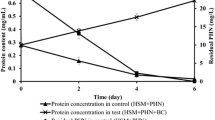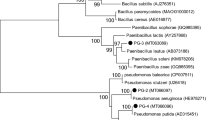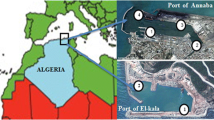Abstract
The halophilic consortium enriched from seagrass present in Jeddah coast region, Saudi Arabia, potently degraded different petroleum hydrocarbons such as phenanthrene (PHE), fluorene (FLU), pyrene (PY) and hexadecane (HD) under saline condition (4%). The halophilic consortium recorded complete degradation of PHE and FLU up to 400 ppm. At 600 ppm of PHE and FLU, the consortium revealed 98% and 99% degradation in 10 days. Further increase in concentration to 800 ppm showed slight decline in the percent degradation of PHE (92%) and FLU (95%) by the halophilic consortium. Pyrene was selected as model compound from high molecular weight hydrocarbons recorded 84% and 78% degradation by the consortium at 50 ppm and 100 ppm in 8 and 10 days, respectively. The halophilic consortium revealed complete degradation of HD at 0.5% and 1% concentration under saline condition. The consortium was able to degrade 93% and 71% of HD at 1.5 and 2% concentration in 6 and 8 days under saline condition. Under different high saline conditions such as 8%, 12%, 16% and 20%, the halophilic consortium exhibited PHE (95%, 90%, 85%, 65%) and FLU (97%, 92%, 86%, 66%) degradation in 7, 10, 14 and 18 days. Addition of urea and yeast extract at high salinity enhanced the biomass production and reduced the time taken for degradation. The surface tension of the biosurfactant produced by the consortium was 36 ± 1 mN/m. The treatment of hydrocarbons-contaminated boat fuel station wastewater in continuous stirred tank reactor recorded 92% Chemical Oxygen Demand removal in 40 days. The potential halophilic strains present in the consortium responsible for petroleum hydrocarbon degradation were identified as Marinobacter, Rhodococcus, Ochrobactrum, Martelella, Pseudomonas, Stenotrophomonas and Sedimentibacter.
Graphic abstract






Similar content being viewed by others
References
Abu-Zied RH, Bantan RA, El Mamoney MH (2011) Present environmental status of the Shuaiba Lagoon, Red Sea Coast, Saudi Arabia. JKAU Mar Sci 22(2):159–179. https://doi.org/10.4197/Mar.22-2.9
Al-Rousan S, Al-Horani F, Eid E, Khalaf M (2011) Assessment of seagrass communities along the Jordanian coast of the Gulf of Aqaba, Red Sea. Mar Biol Res 7(1):93–99. https://doi.org/10.1080/17451001003660319
Alva-Argaez A, Kokossis AC, Smith R (2007) The design of water-using systems in petroleum refining using a water-pinch decomposition. Chem Eng J 128:33–46. https://doi.org/10.1016/j.cej.2006.10.001
APHA (2005) Standard methods for the examination of water and wastewater, 21st edition. In: Rice EW, Baird RB, Eaton AD, Clesceri LS (eds) American Public Health Association, Washington
Arulazhagan P, Vasudevan N (2011) Biodegradation of polycyclic aromatic hydrocarbons by a halotolerant bacterial strain Ochrobactrum sp. VA1. Mar Pollut Bull 62:388–394. https://doi.org/10.1016/j.marpolbul.2010.09.020
Arulazhagan P, Al-Shekri K, Huda Q, Godon JJ, Basahi JM, Jeyakumar D (2017) Biodegradation of polycyclic aromatic hydrocarbons by an acidophilic Stenotrophomonas maltophilia strain AJH1 isolated from a mineral mining site in Saudi Arabia. Extremophiles 21:163–174. https://doi.org/10.1007/s00792-016-0892-0
Auffret M, Yergeau E, Labbe D, Fayolle-Guichard F, Greer CW (2015) Importance of Rhodococcus strains in a bacterial consortium degrading a mixture of hydrocarbons, gasoline, and a diesel oil additives revealed by metatranscriptomic analysis. Appl Microbiol Biotechnol 99:2419–2430. https://doi.org/10.1007/s00253-014-6159-8
Brzeszcz J, Kaszycki P (2018) Aerobic bacteria degrading both n-alkanes and aromatic hydrocarbons: an undervalued strategy for metabolic diversity and flexibility. Biodegradation 29:359–407. https://doi.org/10.1007/s10532-018-9837-x
Dastgheib SMM, Amoozegar MA, Khajeh K, Shavandi M, Ventosa A (2012) Biodegradation of polycyclic aromatic hydrocarbons by a halophilic microbial consortium. Appl Microbiol Biotechnol 95(3):789–798. https://doi.org/10.1007/s00253-011-3706-4
Feng TC, Cui CZ, Dong F, Feng YY, Liu YD, Yang XM (2012) Phenanthrene biodegradation by halophilic Martelella sp. AD-3. J Appl Microbiol 113:779–789. https://doi.org/10.1111/j.1365-2672.2012.05386.x
Gao W, Cui Z, Li Q, Xu G, Jia X, Zheng L (2013) Marinobacter nanhaiticus sp. nov., polycyclic aromatic hydrocarbon-degrading bacterium isolated from the sediment of the South China Sea. Antonie Van Leeuwenhoek 103:485–491. https://doi.org/10.1007/s10482-012-9830-z
Ghosal D, Ghosh S, Dutta TK, Ahn Y (2016) Current state of knowledge in microbial degradation of polycyclic aromatic hydrocarbons (PAHs): a review. Front Microbiol 7:1369. https://doi.org/10.3389/fmicb.2016.01369
Guo G, He F, Tian F, Huang Y, Wang H (2016) Effect of salt contents on enzymatic activities and halophilic microbial community structure during phenanthrene degradation. Int Biodeterior Biodeg 110:8–15. https://doi.org/10.1016/j.ibiod.2016.02.007
Harms H, Smith KEC, Wick LY (2010) Microorganism–hydrophobic compound interactions. In: Timmis KN, McGenity TJ, van der Meer JR, de Lorenzo V (eds) Handbook of hydrocarbon and lipid microbiology. Springer, Berlin, pp 1479–1490. https://doi.org/10.1007/978-3-540-77587-4_101
Huang C, Shi Y, Gamal El-Din M, Liu Y (2015) Treatment of oil sands process-affected water (OSPW) using ozonation combined with integrated fixed-film activated sludge (IFAS). Water Res 85:167–176. https://doi.org/10.1016/j.watres.2015.08.019
Jamal MT (2020) Enrichment of potential halophilic Marinobacter consortium for mineralization of petroleum hydrocarbons and also as oil reservoir indicator in red sea, Saudi Arabia. Polycycl Aromat Compd. https://doi.org/10.1080/10406638.2020.1735456
Jamal MT, Pugazhendi A (2018) Degradation of petroleum hydrocarbons and treatment of refinery wastewater under saline condition by a halophilic bacterial consortium enriched from marine environment (Red Sea), Jeddah, Saudi Arabia. 3Biotech 8:276. https://doi.org/10.1007/s13205-018-1296-x
Jamaly S, Giwa A, Hasan SW (2015) Recent improvements in oily wastewater treatment: progress, challenges, and future opportunities. J Environ Sci 37:15–30. https://doi.org/10.1016/j.jes.2015.04.011
Jiang Z, Huang Y, Xu X, Liao Y, Shou L, Liu J, Chen Q, Zeng J (2010) Advance in the toxic effects of petroleum water accommodated fraction on marine plankton. Acta Ecol Sin 30:8–15. https://doi.org/10.1016/j.chnaes.2009.12.002
Karray F, Aloui F, Jemli M, Mhiri N, Loukil S, Bouhdida R, Mouha N, Sayadi S (2020) Pilot-scale petroleum refinery wastewaters treatment systems: performance and microbial communities analysis. Process Saf Environ Prot 141:73–82. https://doi.org/10.1016/j.psep.2020.05.022
Kiyohara H, Nagao K, Yana K (1982) Rapid screen for bacteria degrading water insoluble, solid hydrocarbons on agar plates. Appl Environ Microbiol 43:454–457
Kuyukina MS, Krivoruchko AV, Ivshina IB (2020) Advanced bioreactor treatments of hydrocarbon-containing wastewater. Appl Sci 10(3):831. https://doi.org/10.3390/app10030831
Lewis M, Pryor R (2013) Toxcities of oils, dispersants and dispersed oils to algae and aquatic plants: review and database value to resource sustainability. Environ Poll 180:345–467. https://doi.org/10.1016/j.envpol.2013.05.001
Liu YF, Galzerani DD, Mbadinga SM, Zaramela LS, Gu JG, Mu BZ, Zengler K (2018) Metabolic capability and in situ activity of microorganisms in an oil reservoir. Microbiome 6:5. https://doi.org/10.1186/s40168-017-0392-1
Mahjoubi M, Cappello S, Souissi Y, Jaouani A, Cherif A (2018) Microbial bioremediation of petroleum hydrocarbon–contaminated marine environments. Chapter 16:325–350. https://doi.org/10.5772/intechopen.72207
Medic A, Ljesevic M, Inui H, Beskoski V, Kojic I, Stojanovic K, Karadzic I (2020) Efficient biodegradation of petroleum n-alkanes and polycyclic aromatic hydrocarbons by polyextremophilic Pseudomonas aeruginosa san ai with multidegradative capacity. RSC Adv 10:14060–14070. https://doi.org/10.1039/C9RA10371F
Mnif S, Chamkha M, Sayadi S (2009) Isolation and characterization of Halomonas sp. strain C2SS100, a hydrocarbon-degrading bacterium under hypersaline conditions. J Appl Microbiol 107:785–794. https://doi.org/10.1111/j.1365-2672.2009.04251.x
Mnif S, Chamkha M, Labat M, Sayadi S (2011) Simultaneous hydrocarbon biodegradation and biosurfactant production by oil field-selected bacteria. J Appl Microbiol 111:525–536. https://doi.org/10.1111/j.1365-2672.2011.05071.x
Mnif S, Sayadi S, Chamkha M (2014) Biodegradative potential and characterization of a novel aromatic-degrading bacterium isolated from a geothermal oil field under saline and thermophilic conditions. Int Biodeterior Biodegrad 86:258–264. https://doi.org/10.1016/j.ibiod.2013.09.015
Mohanty G, Mukherji S (2008) Enhancement of NAPL bioavailability by induction of cell-surface hydrophobicity in Exiguobacterium aurantiacum and Burkholderia cepacia. Ind J Biotechnol 7(3):295–306
Ondiviela B, Losada IJ, Lara JL, Maza M, Galván C, Bouma TJ, Belzen JV (2014) The role of seagrasses in coastal protection in a changing climate. Coastal Eng 87:158–168. https://doi.org/10.1016/j.coastaleng.2013.11.005
Pugazhendi A, Qari H, Basahi JMA, Godon JJ, Dhavamani J (2017) Role of a halothermophilic bacterial consortium for the biodegradation of PAHs and the treatment of petroleum wastewater at extreme conditions. Int Biodeterior Biodeg 121:44–54. https://doi.org/10.1016/j.ibiod.2017.03.015
Qurban MAB, Karuppasamy M, Krishnakumar PK, Garcias-Bonet N, Duarte CM (2019) Seagrass distribution, composition and abundance along the Saudi Arabian coast of red sea. In: Rasul N, Stewart I (eds) Oceanographic and biological aspects of the Red Sea Springer Oceanography. Springer, Cham, pp 367–385. https://doi.org/10.1007/978-3-319-99417-8_20
Roy M, Khara P, Dutta TK (2012) meta-Cleavage of hydroxynaphthoic acids in the degradation of phenanthrene by Sphingobium sp. strain PNB. Microbiology 158:685–695. https://doi.org/10.1099/mic.0.053363-0
Sorokin DY, Janssen AJH, Muyzer G (2012) Biodegradation potential of halo(alkali)philic prokaryotes. Crit Rev Environ Sci Technol 42:811–856. https://doi.org/10.1080/10643389.2010.534037
Tao L, Hua WF, Ping GL, Liang LX, Jin YX, Jun LA (2012) Biodegradation of n-hexadecane by bacterial strains B1 and B2 isolated from petroleum-contaminated soil. Sci China Chem 55(9):1968–1975. https://doi.org/10.1007/s11426-012-4618-6
Taylor MD, Fry B, Becker A, Moltschaniwskyj N (2017) Recruitment and connectivity influence the role of seagrass as a penaeid nursery habitat in a wave dominated estuary. Sci Total Environ 584:622–630. https://doi.org/10.1016/j.scitotenv.2017.01.087
Tellez G, Nirmalakhandan N, Gardea-Torresdey JL (2005) Kinetic evaluations of a field-scale activated sludge system for removing petroleum hydrocarbons from oilfield-produced water. Environ Prog 24:96–104. https://doi.org/10.1002/ep.10042
Turner NR, Renegar DA (2017) Petroleum hydrocarbon toxicity to corals: a review. Mar Poll Bull 2(119):1–16. https://doi.org/10.1016/j.marpolbul.2017.04.050
Varjani SJ, Rana DP, Jain AK, Bateja S, Upasani VN (2015) Synergistic ex situ biodegradation of crude oil by halotolerant bacterial consortium of indigenous strains isolated from on shore sites of Gujarat, India. Int Biodeterior Biodegrad 103:116–124. https://doi.org/10.1016/j.ibiod.2015.03.030
Veil JA (2015) U.S. produced water volumes and management practices in 2012. Veil Environmental, LLC, Annapolis, p 119
Wei X, Zhang S, Han Y, Wolfe FA (2019) Treatment of petrochemical wastewater and produced water from oil and gas. Water Environ Res 91:1025–1033. https://doi.org/10.1002/wer.1172
Wilson KG, Ralph PJ (2012) Laboratory testing protocol for the impact of dispersed petrochemicals on seagrass. Mar Poll Bull 64(11):2421–2427. https://doi.org/10.1016/j.marpolbul.2012.08.004
Xu X, Liu W, Tian S, Wang W, Qi Q, Jiang P, Gao X, Li F, Li H, Yu H (2018) Petroleum hydrocarbon-degrading bacteria for the remediation of oil pollution under aerobic conditions: a perspective analysis. Front Microbiol 9:2885. https://doi.org/10.3389/fmicb.2018.02885
Acknowledgements
This project was funded by Deanship of Scientific Research (DSR) at King Abdulaziz University, Jeddah, under Grant No. G-535-150-1439. The authors, therefore, acknowledge with thanks DSR for technical and financial support.
Author information
Authors and Affiliations
Contributions
MTJ contributed to project administration, execution of project, execution of research work, data collection and article preparation. AP equally contributed in execution of research work, reactor design, data collection, evaluation and article preparation.
Corresponding author
Ethics declarations
Conflict of interest
The authors declare that they have no conflict of interest.
Additional information
Publisher's Note
Springer Nature remains neutral with regard to jurisdictional claims in published maps and institutional affiliations.
Rights and permissions
About this article
Cite this article
Jamal, M.T., Pugazhendi, A. Isolation and characterization of halophilic bacterial consortium from seagrass, Jeddah coast, for the degradation of petroleum hydrocarbons and treatment of hydrocarbons-contaminated boat fuel station wastewater. Clean Techn Environ Policy 23, 77–88 (2021). https://doi.org/10.1007/s10098-020-01957-1
Received:
Accepted:
Published:
Issue Date:
DOI: https://doi.org/10.1007/s10098-020-01957-1




